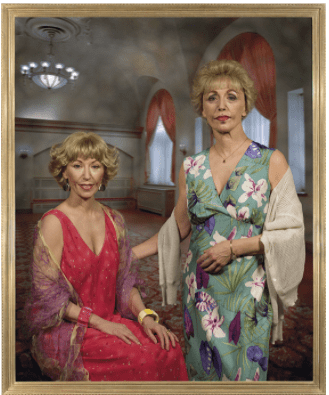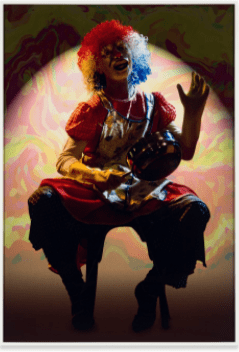Martin Xie, On Cindy Sherman

Cindy Sherman, Untitled #475 (2008). Photograph.
I was first introduced to Cindy Sherman through one of the NYU summer program courses. This piece is what I saw during the lecture, and I didn’t really want to look at it anymore after the first glance. The figures had a weird wax texture to them and everything else made me feel untouched: the bored and basic setting, the vibrant yet lifeless colors of the dresses, the perfectly stiff makeup…it was hard to look at even though it seemed like it should be a very conventional photograph. Perhaps (or certainly, after my classmates shared their opinions on it) that is the point. Because we (at least I) expect these middle-aged caucasian ladies in ballroom portraits to be what they usually are: a photo to remember the good times they had there. Which may be fun and personal for them, but it’s not quite art museum material. Something is off here, and the photo doesn’t seem to have that joy or intimacy in it. As a consequence, it’s alienating and hard on the eyes because it was the opposite of what I expected from this nature of photos. At this point, I realized why I didn’t enjoy looking at the photo: because of how it didn’t fit into the cliché, not because of how it did. From a series called “Society Portraits” (2008), this photo was created by Sherman whilst approaching the fifth decade of her career.
 Cindy Sherman, Untitled #426 (2004).
Cindy Sherman, Untitled #426 (2004).
What sets this series apart from her previous works of the clown photographs (2003-4) is that they are less grand and comically skewed. But even without the drama on a grand scale, there is a visible tension within the image. If we look at how uncomfortable and pretending the two figures are, the sad nature of the portrait comes out. Their faces are stiff not from the makeup itself, but rather from the practice of cosmetic surgery which is expected for women of their age and status. In addition, the subjects are positioned awkwardly, and to be honest, no one is really smiling. It shows the struggle of a few individuals against a whole system, hence the name “Society Portraits.” Society may be the underlying antagonist here. You see, when I first looked at this piece and thought nothing deep of it, it was because it looked like any other portrait of some middle-aged caucasian ladies. That may be pretty for Instagram or in this case, Facebook, it’s not that deep in its essence. I even had that prejudice ready in my head: “Ugh, this is such a common photo for people to have. Why are we even shown this in an arts course?” But this is the exact same stereotype that was forced upon the subjects. They are doing what every other woman like them is doing, unfortunately for them, it doesn’t come naturally. Even though no one knows the full story behind the ladies, we see it for sure that they’re out of their character. In fact, there might not even be a distinguishable character here. We do get a sense of what’s going on in the photo, but the look is still too broad, too general. Which going back, makes sense since they shot this picture to deceive and thus nothing in it seems personal and special. It’s interesting that Sherman is solely representing a group of people in a slightly different way, yet suddenly, with a bit of attention everyone can sense what’s off about it.
Cindy Sherman has created a whole new world with her art. There are otherworldly clowns, fake vintage movie stills, and the Society Portraits. However, this world of hers seems to reflect the not-so-glamorous side of our world instead of being just another fictional world. Just like this society portrait, her works often have a blurred line between the real and the fake. Sherman may have never shown us her true personality because she’s constantly switching roles in every piece of her work, but what she thinks about our society is strongly reflected in her art. There are many layers to her artistry and style, including the fact that she always uses herself as the subject, and in this one, she dresses up as two people. Though she has said that she only does it because it’s convenient, it unavoidably shows small details of her artist traits. Because while many photographers are afraid to shoot themselves and enjoy a diverse range of models to play different roles, Sherman is the master of disguise and is comfortable with just herself doing everything. And the characters that she chooses to play reveals what she’s experienced as a human. The seemingly fake wax-like figures are the results of very real standards and expectations created by the people around her.
As the two Cindys stare at the viewer with an effortful though not quite accomplished smile, it’s not clear whether they’re accepting their fate or seeking help to free them from it. Yet, there’s one clear message conveyed in all of her works, that the women in the photographs have been robbed of their freedom for far too long.
1)Phaidon. 2014. “The Truth About Cindy Sherman’s Society Portraits.” https://www.phaidon.com/agenda/art/articles/2014/february/04/the-truth-about-cindy-shermans-society-portraits/
2) Students of Miami University. Academic year of 2019-2020. “M8 Discussion Art-183.” https://www.studocu.com/en-us/document/miami-university/images-of-america/m8-discussion-art-183/12003380.